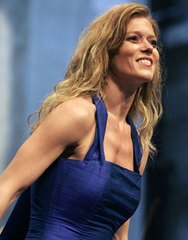|
Back
Methods in Their Madness New York
Isaac Stern Auditorium, Carnegie Hall
01/17/2016 - & January 14, 15, 2016 (Cleveland)
Hans Abrahamsen: let me tell you (New York premiere)
Dmitri Shostakovich: Symphony No. 4 in C Minor, Opus 43
Barbara Hannigan (Soprano)
The Cleveland Orchestra, Franz Welser-Möst (Music Director and Conductor)

B. Hannigan (© Barbarahannigan.com)
”There, outside, were the bare cobbles; and here, inside, was the snow. Snow growing heavier each day, muffling the world, hiding the ugly, and deadening...”
Conrad Aiken: From Silent Snow, Secret Snow
Runner-up for the most frightening story about growing mania inside an innocent mortal is Conrad Aiken’s great Silent Snow, Secret Snow. yet it is eclipsed, of course, by Ophelia’s growing madness in Hamlet. And therein lies the tale of last night’s let me tell you, Danish composer Hans Abrahamsen’s gorgeous and frightening piece for soprano and orchestra.
To make this complex background simple, critic-novelist-librettist Paul Griffiths took the 481 words uttered by Shakespeare’s Ophelia, configuring them in countless different shapes for his latest novel, let me tell you From this novel, he excerpted seven divisions, each a song from the deceivingly minimalist Mr. Abrahamsen.
And just as Shakespeare wrote his major roles for particular actors in his repertory companies, so Mr. Abrahamsen wrote this 30-minute work for (in Shakespeare’s words) “its onlie begetter”, Barbara Hannigan. Whether or not she is the world’s finest soprano, I can think of no other singer whose emotional range marries her vocal range so incisively. It is impossible to imagine any other artist singing these simple (and literally mad) verses, giving voice to the subjects of memory, time. light, music, glass and, yes, snow.

H. Abrahamsen (© MusicSalesClassical)
Mr. Abrahamsen has been obsessed with snow in much of his musical life, but with Mr. Griffith’s verses, he hears snow orchestrally along with glass and light (“You have made me like glass–like glass in an ecstasy from your light…like glass in which there are showers of light…that cannot end”). And with a Donne-like metaphysic of time and music (“...I remember when we had no music, a time when there was no time for music, and what is music if not time–...”).
Yet there is always, as in the background of Aiken’s story, the feeling of snow. That feeling in the last verse (“The snow flowers are all like each other, and I cannot keep my eyes on one”), where his orchestra, and soprano Brannigan slowly almost silently fall. Her voice, the strings, the harp in the background, other amorphous groups of instruments all part of the snow, seeing it come down.
Yet there is more here beneath the so sensitive orchestration and singing. The first song with its celesta and harp and quiet aria brings one immediately to a medieval time, particularly to the 15th Century model for Hamlet’s Elsinore Castle.
While the aria is simple, Ms. Hannigan employs throughout the work a rhythmic repetition of syllables, what Monteverdi called trillo. Musically this was perhaps a musical affectation. But pictorially, I go out on a limb and feel these repetitions were like the soft echoes of sounds against the great stone bulwarks of the original fortress. Who knows?
Her next two songs, on memory and time, used the same shadowy orchestration, single lines, a few outbursts, and Ms. Brannigan singing, sometimes simply and frequently rising up a good 13 notes in the scale with that same ease, that inevitability.
Only once was the huge orchestra used at its most powerful, in the fifth song: the breaking of glass, the madness of nocturnal and diurnal (“...I do not mind if it is day, if it is night”), and a few vocalizations of birds. But it is in the seventh song, where Ophelia “will go on in the snow” that one feels the falling, the sheer white on white until paper rubbing against a drum, in the composer’s words, “like walking in the snow”. (An homage to Debussy?)
Two astute friends in the audience felt that, while giving due respect to the piece, they felt no emotional pull. Maybe they were waiting Bayeux tapestry instead of a Persian miniature. For myself, I was taken in from the beginning. And while I still believe that Ophelia’s drowning death in the dank corridors of the black-and-white castle–Jean Simmons in the Olivier Hamlet–was the most harrowing of all, Mr. Abrahamsen and Ms. Brannigan gave a memorable homage to the shape and misshape of memory itself.
No mention has been made of the Cleveland Orchestra and Franz Welser-Möst , any more than one speaks about great acting in a drama. The drama of let me tell you was its own reward. But that great ensemble was led with the utmost sensitivity here–as it was in that other truly rare selection, Dmitri Shostakovich’s C Minor Symphony.
I confess now that I had never heard the complete Fourth. It is hardly ever played here or anywhere else, the composer himself had to wait three decades to hear it (the original orchestra rebelled!), and it is a most puzzling work.
Yet puzzlement doesn’t begin to describe its crazy changes of moods, its banalities, glories, funeral and military marches, turbulences, merry-go-round waltzes, garish richness and enigmatic emptiness. Mr. Welser-Möst may have attempted a cohesion, but nothing coheres here except the short second movement, which is constantly dark and relentless. The rest, like Mahler’s “embrace of the whole world” is a Big Bang ejecting planets, meteors, suns and parallel universes.
But oh, how the Cleveland Orchestra played this to the umpteenth degree! That string section, which plays a half-dozen fugues in prestissimo tempos, was shimmering. The all-important bassoon solos by John Crowser were splendid, as was an unexpected low-string solo by William Precil.
It was Mr. Welser-Möst , though, who made this amalgamation almost sound unified. That is, he did the best he could do.
As if the conductor was saying to us, “Don’t worry about making sense. Ophelia had a gorgeous madness in Mr. Abrahamsen’s music. Shostakovich is a wee bit lunatic in this Fourth Symphony as well, so don’t worry, don’t be frightened.
As the Bard himself wrote, “If this be mad, such madness has the oddest frame of sense.”
Harry Rolnick
|